Dual-Energy Computed Tomography Applications to Reduce Metal Artifacts in Hip Prostheses: A Phantom Study
Abstract
1. Introduction
2. Materials and Methods
2.1. Spectral CT Using Fast kV Switching Technique
2.2. Hip Phantom and Prostheses
- -
- Triplets of 10-mm were placed (i) in contact with the prosthetic stem at mid length in lateral and medial position (b1, b3) and in distal position (b2); (ii) in contact with the acetabular cup in medial and lateral position (b4, b5); and (iii) in the distal region, far from metal parts (br).
- -
- Miniaturized 5-mm triplets were placed in contact with the prosthetic neck in lateral and medial positions (s1, s2).
- -
- Two HA calibrated densitometric pellets (Skyscan, Aartselaar, Belgium) were positioned (i) in contact with acetabular cup (calibrated concentrations of hydroxyapatite (HA) of 0.25 g/cm3); and (ii) in contact with stem in the greater trochanter region (calibrated concentrations of hydroxyapatite (HA) of 0.75 g/cm3).
2.3. Image Acquisition and Reconstruction
2.4. Quantitative Analysis of Metal Artifacts
2.5. Statistical Analysis
3. Results
3.1. Qualitative Analysis
3.2. Quantitative Analysis
4. Discussion
5. Conclusions
Supplementary Materials
Author Contributions
Funding
Institutional Review Board Statement
Informed Consent Statement
Data Availability Statement
Acknowledgments
Conflicts of Interest
References
- Man, B.D.; Nuyts, J.; Dupont, P.; Marchal, G.; Suetens, P. Metal Streak Artifacts in X-ray Computed Tomography: A Simulation Study. In Proceedings of the 1998 IEEE Nuclear Science Symposium Conference Record. 1998 IEEE Nuclear Science Symposium and Medical Imaging Conference (Cat. No.98CH36255), Toronto, ON, Canada, 8–14 November 1998. [Google Scholar] [CrossRef]
- Joseph, P.M.; Spital, R.D. The Exponential Edge-Gradient Effect in x-Ray Computed Tomography. Phys. Med. Biol. 1981, 26, 473–487. [Google Scholar] [CrossRef]
- Roth, T.D.; Maertz, N.A.; Parr, J.A.; Buckwalter, K.A.; Choplin, R.H. CT of the Hip Prosthesis: Appearance of Components, Fixation, and Complications. RadioGraphics 2012, 32, 1089–1107. [Google Scholar] [CrossRef]
- Blum, A.; Meyer, J.-B.; Raymond, A.; Louis, M.; Bakour, O.; Kechidi, R.; Chanson, A.; Gondim-Teixeira, P. CT of Hip Prosthesis: New Techniques and New Paradigms. Diagn. Interv. Imaging 2016, 97, 725–733. [Google Scholar] [CrossRef]
- Filograna, L.; Magarelli, N.; Leone, A.; Guggenberger, R.; Winklhofer, S.; Thali, M.J.; Bonomo, L. Value of Monoenergetic Dual-Energy CT (DECT) for Artefact Reduction from Metallic Orthopedic Implants in Post-Mortem Studies. Skelet. Radiol. 2015, 44, 1287–1294. [Google Scholar] [CrossRef]
- Higashigaito, K.; Angst, F.; Runge, V.M.; Alkadhi, H.; Donati, O.F. Metal Artifact Reduction in Pelvic Computed Tomography With Hip Prostheses: Comparison of Virtual Monoenergetic Extrapolations From Dual-Energy Computed Tomography and an Iterative Metal Artifact Reduction Algorithm in a Phantom Study. Investig. Radiol. 2015, 50, 828–834. [Google Scholar] [CrossRef]
- Wellenberg, R.H.H.; Boomsma, M.F.; van Osch, J.A.C.; Vlassenbroek, A.; Milles, J.; Edens, M.A.; Streekstra, G.J.; Slump, C.H.; Maas, M. Quantifying Metal Artefact Reduction Using Virtual Monochromatic Dual-Layer Detector Spectral CT Imaging in Unilateral and Bilateral Total Hip Prostheses. Eur. J. Radiol. 2017, 88, 61–70. [Google Scholar] [CrossRef]
- Neuhaus, V.; Große Hokamp, N.; Abdullayev, N.; Rau, R.; Mpotsaris, A.; Maintz, D.; Borggrefe, J. Metal Artifact Reduction by Dual-Layer Computed Tomography Using Virtual Monoenergetic Images. Eur. J. Radiol. 2017, 93, 143–148. [Google Scholar] [CrossRef]
- Kosmas, C.; Hojjati, M.; Young, P.C.; Abedi, A.; Gholamrezanezhad, A.; Rajiah, P. Dual-Layer Spectral Computerized Tomography for Metal Artifact Reduction: Small versus Large Orthopedic Devices. Skelet. Radiol. 2019, 48, 1981–1990. [Google Scholar] [CrossRef]
- Huang, J.Y.; Kerns, J.R.; Nute, J.L.; Liu, X.; Balter, P.A.; Stingo, F.C.; Followill, D.S.; Mirkovic, D.; Howell, R.M.; Kry, S.F. An Evaluation of Three Commercially Available Metal Artifact Reduction Methods for CT Imaging. Phys. Med. Biol. 2015, 60, 1047–1067. [Google Scholar] [CrossRef]
- Lee, Y.H.; Park, K.K.; Song, H.-T.; Kim, S.; Suh, J.-S. Metal Artefact Reduction in Gemstone Spectral Imaging Dual-Energy CT with and without Metal Artefact Reduction Software. Eur. Radiol. 2012, 22, 1331–1340. [Google Scholar] [CrossRef]
- Komlosi, P.; Grady, D.; Smith, J.S.; Shaffrey, C.I.; Goode, A.R.; Judy, P.G.; Shaffrey, M.; Wintermark, M. Evaluation of Monoenergetic Imaging to Reduce Metallic Instrumentation Artifacts in Computed Tomography of the Cervical Spine. J. Neurosurg. Spine 2015, 22, 34–38. [Google Scholar] [CrossRef]
- Meinel, F.G.; Bischoff, B.; Zhang, Q.; Bamberg, F.; Reiser, M.F.; Johnson, T.R.C. Metal Artifact Reduction by Dual-Energy Computed Tomography Using Energetic Extrapolation: A Systematically Optimized Protocol. Investig. Radiol. 2012, 47, 406–414. [Google Scholar] [CrossRef]
- De Crop, A.; Casselman, J.; Van Hoof, T.; Dierens, M.; Vereecke, E.; Bossu, N.; Pamplona, J.; D’Herde, K.; Thierens, H.; Bacher, K. Analysis of Metal Artifact Reduction Tools for Dental Hardware in CT Scans of the Oral Cavity: KVp, Iterative Reconstruction, Dual-Energy CT, Metal Artifact Reduction Software: Does It Make a Difference? Neuroradiology 2015, 57, 841–849. [Google Scholar] [CrossRef]
- Wellenberg, R.H.H.; Donders, J.C.E.; Kloen, P.; Beenen, L.F.M.; Kleipool, R.P.; Maas, M.; Streekstra, G.J. Exploring Metal Artifact Reduction Using Dual-Energy CT with Pre-Metal and Post-Metal Implant Cadaver Comparison: Are Implant Specific Protocols Needed? Skelet. Radiol. 2018, 47, 839–845. [Google Scholar] [CrossRef]
- Kim, J.; Park, C.; Jeong, H.S.; Song, Y.S.; Lee, I.S.; Jung, Y.; Lee, S.M. The Optimal Combination of Monochromatic and Metal Artifact Reconstruction Dual-Energy CT to Evaluate Total Knee Replacement Arthroplasty. Eur. J. Radiol. 2020, 132, 109254. [Google Scholar] [CrossRef]
- Vellarackal, A.J.; Kaim, A.H. Metal Artefact Reduction of Different Alloys with Dual Energy Computed Tomography (DECT). Sci. Rep. 2021, 11, 2211. [Google Scholar] [CrossRef]
- Slavic, S.; Madhav, P.; Profio, M.; Crotty, D.; Nett, E.; Hsieh, J.; Liu, E. GSI Xtream on Revolution CT—White Paper. 2017. Available online: https://www.gehealthcare.com/-/media/069734962cbf45c1a5a01d1cdde9a4cd.pdf (accessed on 14 September 2022).
- Bolstad, K.; Flatabø, S.; Aadnevik, D.; Dalehaug, I.; Vetti, N. Metal Artifact Reduction in CT, a Phantom Study: Subjective and Objective Evaluation of Four Commercial Metal Artifact Reduction Algorithms When Used on Three Different Orthopedic Metal Implants. Acta Radiol. 2018, 59, 1110–1118. [Google Scholar] [CrossRef]
- Andersson, K.M.; Nowik, P.; Persliden, J.; Thunberg, P.; Norrman, E. Metal Artefact Reduction in CT Imaging of Hip Prostheses—An Evaluation of Commercial Techniques Provided by Four Vendors. Br. J. Radiol. 2015, 88, 20140473. [Google Scholar] [CrossRef]
- Reynoso, E.; Capunay, C.; Rasumoff, A.; Vallejos, J.; Carpio, J.; Lago, K.; Carrascosa, P. Periprosthetic Artifact Reduction Using Virtual Monochromatic Imaging Derived From Gemstone Dual-Energy Computed Tomography and Dedicated Software. J. Comput. Assist. Tomogr. 2016, 40, 649–657. [Google Scholar] [CrossRef]
- Fang, J.; Zhang, D.; Wilcox, C.; Heidinger, B.; Raptopoulos, V.; Brook, A.; Brook, O.R. Metal Implants on CT: Comparison of Iterative Reconstruction Algorithms for Reduction of Metal Artifacts with Single Energy and Spectral CT Scanning in a Phantom Model. Abdom. Radiol. 2017, 42, 742–748. [Google Scholar] [CrossRef]
- Jeong, J.; Kim, H.; Oh, E.; Cha, J.G.; Hwang, J.; Hong, S.S.; Chang, Y.W. Visibility of Bony Structures around Hip Prostheses in Dual-Energy CT: With or without Metal Artefact Reduction Software. J. Med. Imaging Radiat. Oncol. 2018, 62, 634–641. [Google Scholar] [CrossRef]
- Guziński, M.; Kubicki, K.; Waszczuk, Ł.; Morawska-Kochman, M.; Kochman, A.; Sąsiadek, M. Dual-Energy Computed Tomography in Loosening of Revision Hip Prosthesis: A Comparison Between MARS and Non-MARS Images. J. Comput. Assist. Tomogr. 2019, 43, 379–385. [Google Scholar] [CrossRef]
- Report of, R.I.P.O. Regional Register of Orthopaedic Prosthetic Implantology, Overall Data Hip, Knee and Shoulder Arthroplasty in Emilia Romagna (Italy) 2000–2019. Available online: https://Ripo.Cineca.It/Authzssl/Pdf/Annual%20report%202019%20RIPO%20Register_v1.Pdf (accessed on 15 September 2022).
- NIST: X-ray Mass Attenuation Coefficients—Bone, Cortical. Available online: https://physics.nist.gov/PhysRefData/XrayMassCoef/ComTab/bone.html (accessed on 6 December 2022).
- NIST: X-ray Mass Atten. Coef.—Tissue, Soft (ICRU-44). Available online: https://physics.nist.gov/PhysRefData/XrayMassCoef/ComTab/tissue.html (accessed on 6 December 2022).
- Han, S.C.; Chung, Y.E.; Lee, Y.H.; Park, K.K.; Kim, M.J.; Kim, K.W. Metal Artifact Reduction Software Used With Abdominopelvic Dual-Energy CT of Patients With Metal Hip Prostheses: Assessment of Image Quality and Clinical Feasibility. Am. J. Roentgenol. 2014, 203, 788–795. [Google Scholar] [CrossRef]
- Dabirrahmani, D.; Magnussen, J.; Appleyard, R.C. Dual-Energy Computed Tomography—How Accurate Is Gemstone Spectrum Imaging Metal Artefact Reduction? Its Application to Orthopedic Metal Implants. J. Comput. Assist. Tomogr. 2015, 39, 925–935. [Google Scholar] [CrossRef]
- Wang, F.; Xue, H.; Yang, X.; Han, W.; Qi, B.; Fan, Y.; Qian, W.; Wu, Z.; Zhang, Y.; Jin, Z. Reduction of Metal Artifacts From Alloy Hip Prostheses in Computer Tomography. J. Comput. Assist. Tomogr. 2014, 38, 828–833. [Google Scholar] [CrossRef]
- Hsieh, J. Computed Tomography: Principles, Design, Artifacts, and Recent Advances, 2nd ed.; Wiley Interscience: Hoboken, NJ, USA; SPIE Press: Bellingham, WA, USA, 2009; ISBN 978-0-470-56353-3. [Google Scholar]
- Mohammadi, K.; Hassani, M.; Ghorbani, M.; Farhood, B.; Knaup, C. Evaluation of the Accuracy of Various Dose Calculation Algorithms of a Commercial Treatment Planning System in the Presence of Hip Prosthesis and Comparison with Monte Carlo. J. Can. Res. Ther. 2017, 13, 501. [Google Scholar] [CrossRef]
- Jamari, J.; Ammarullah, M.I.; Santoso, G.; Sugiharto, S.; Supriyono, T.; van der Heide, E. In Silico Contact Pressure of Metal-on-Metal Total Hip Implant with Different Materials Subjected to Gait Loading. Metals 2022, 12, 1241. [Google Scholar] [CrossRef]
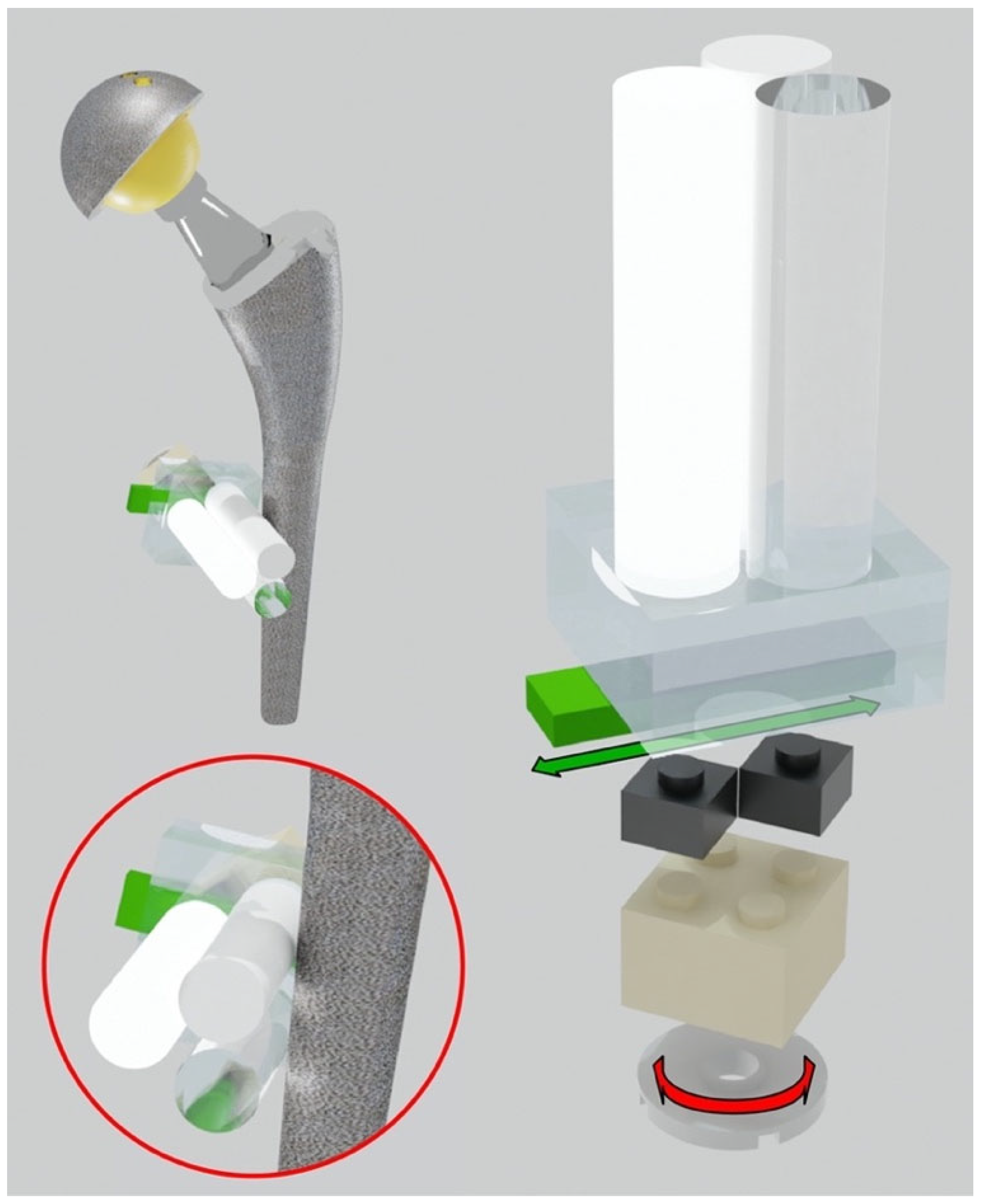
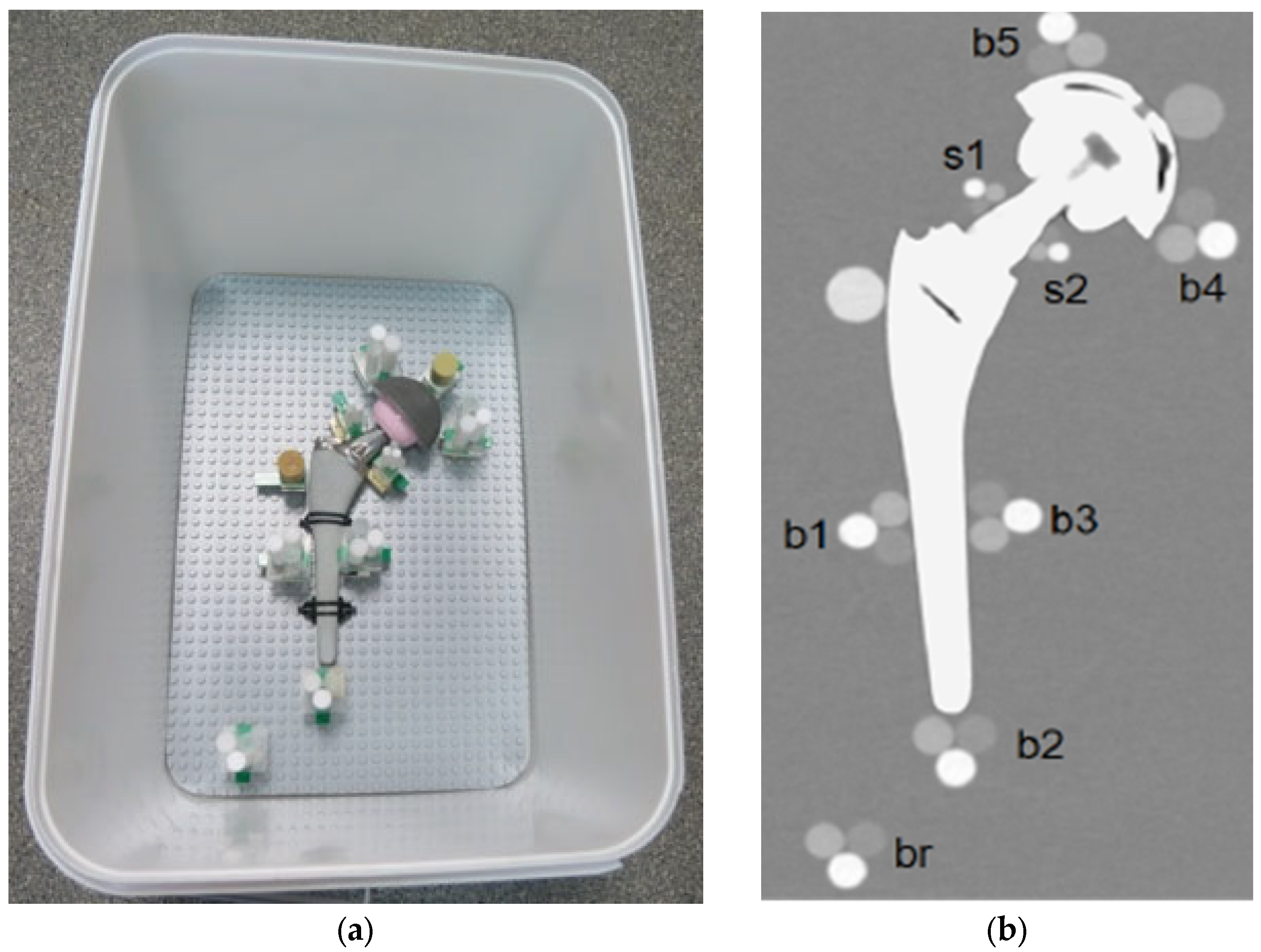
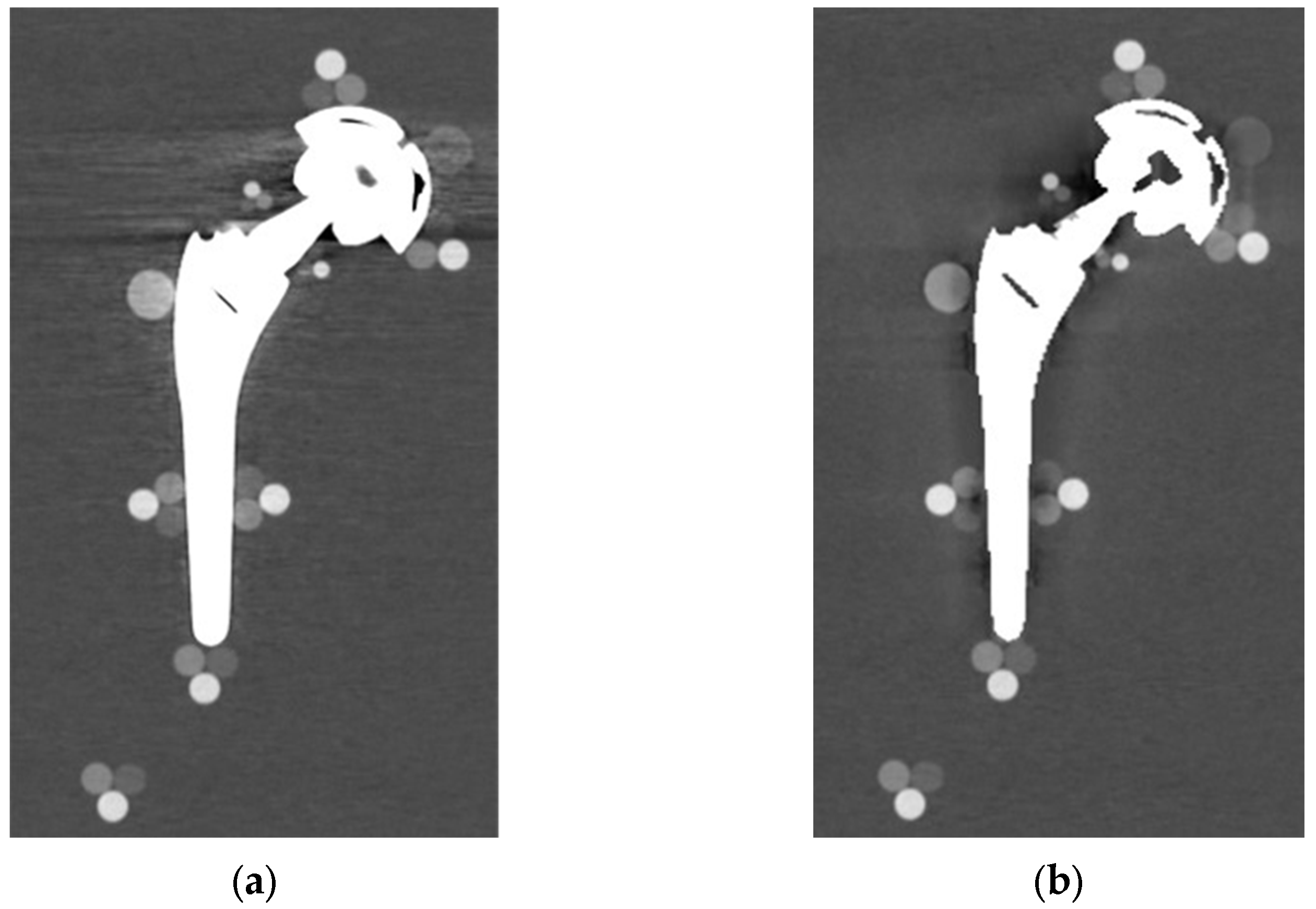

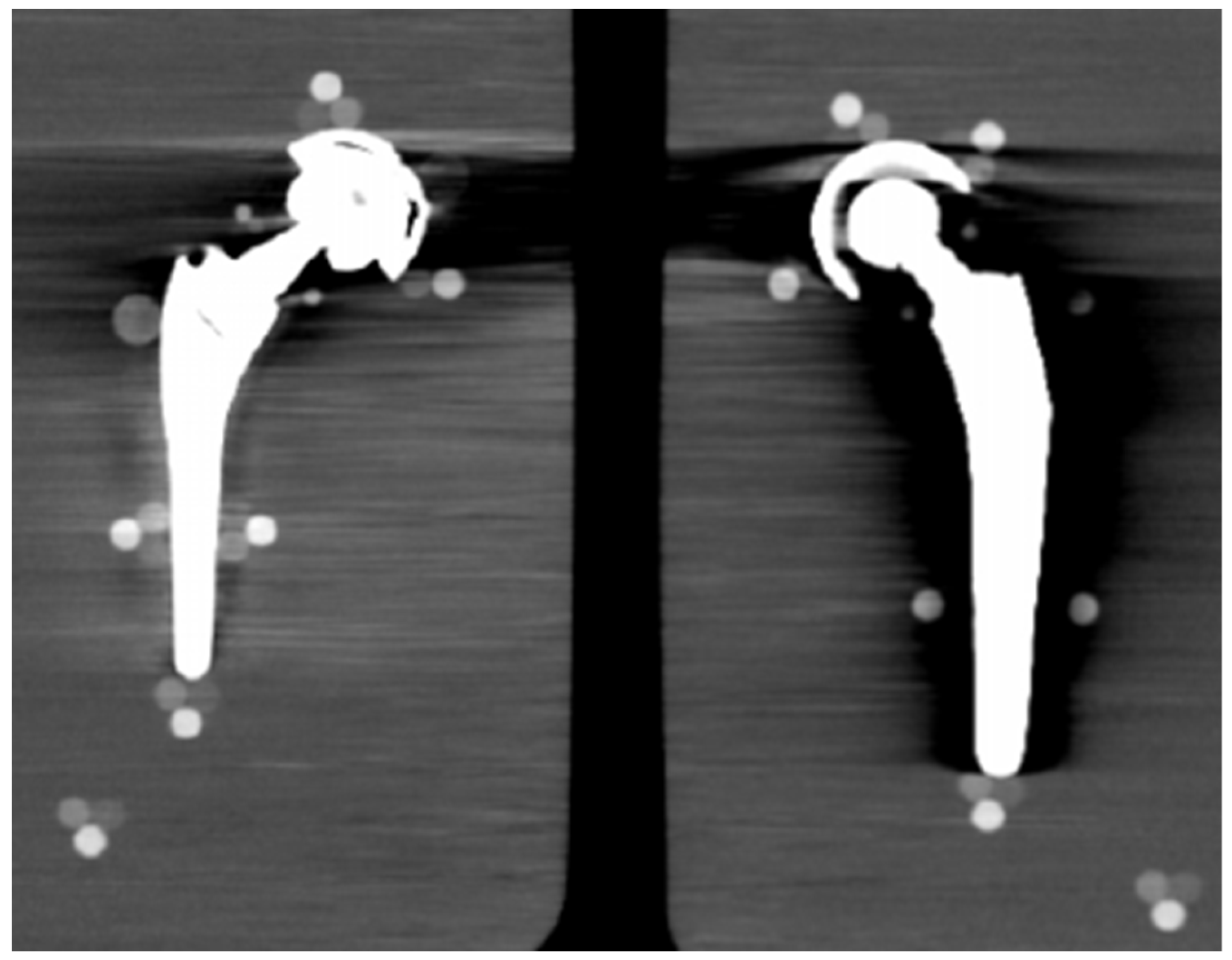
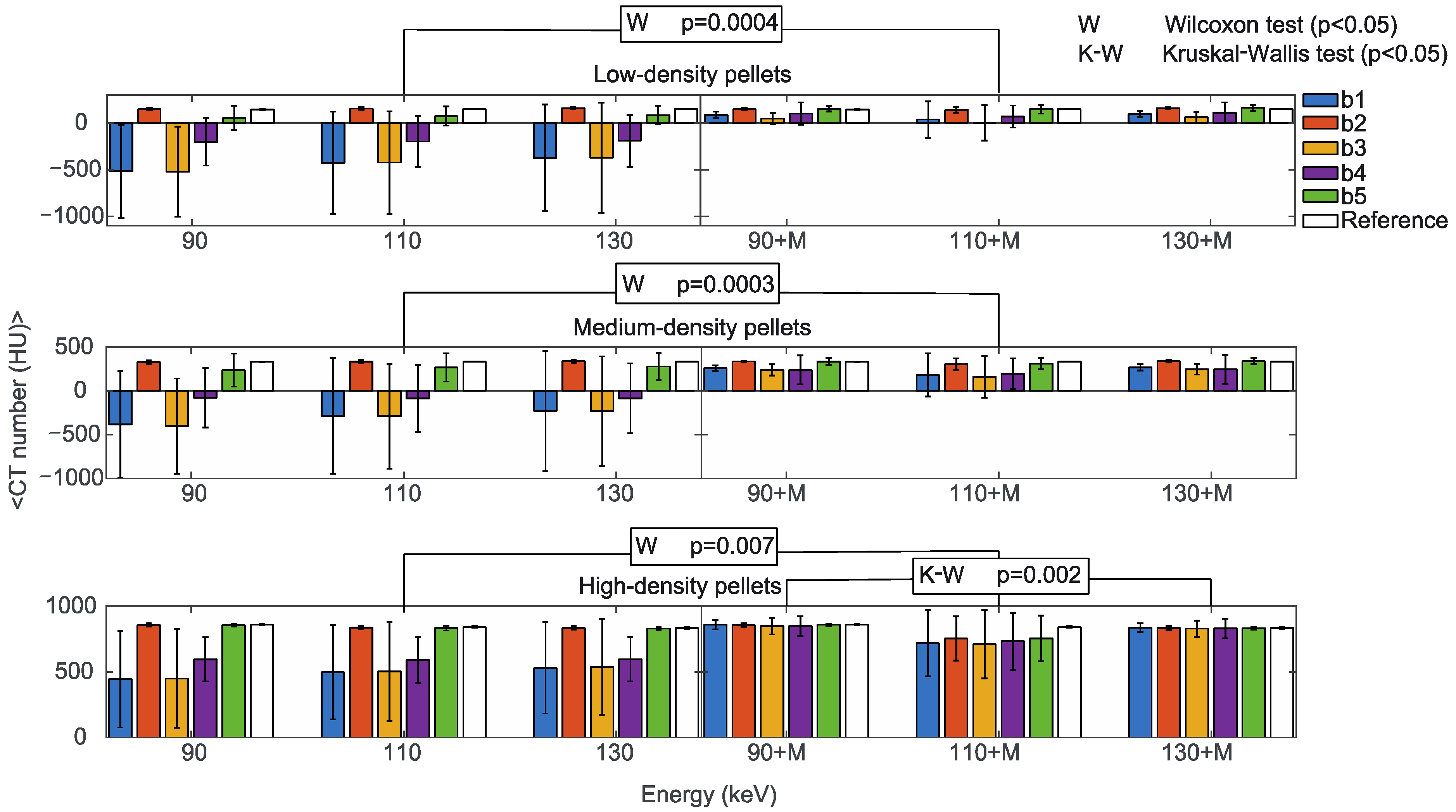

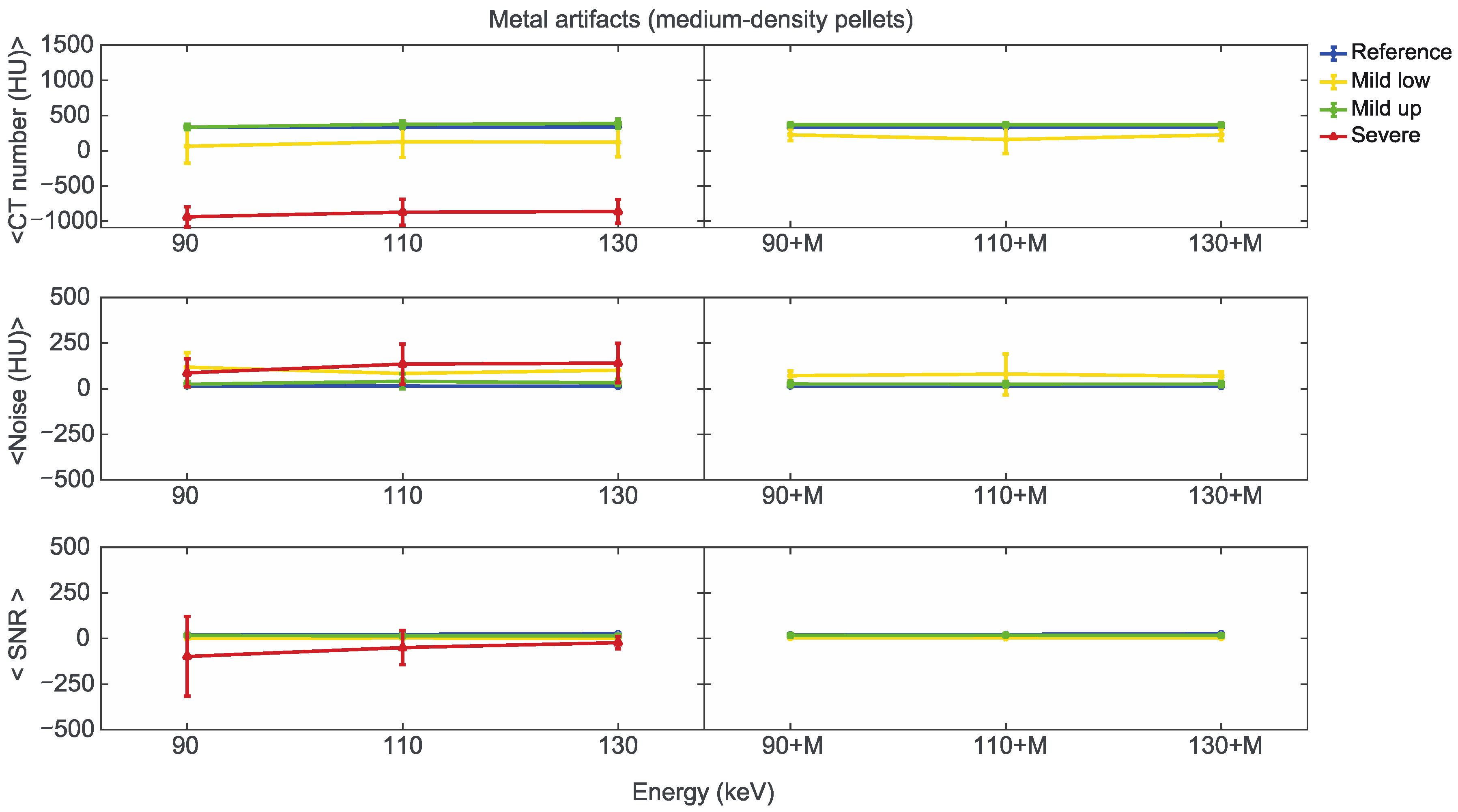
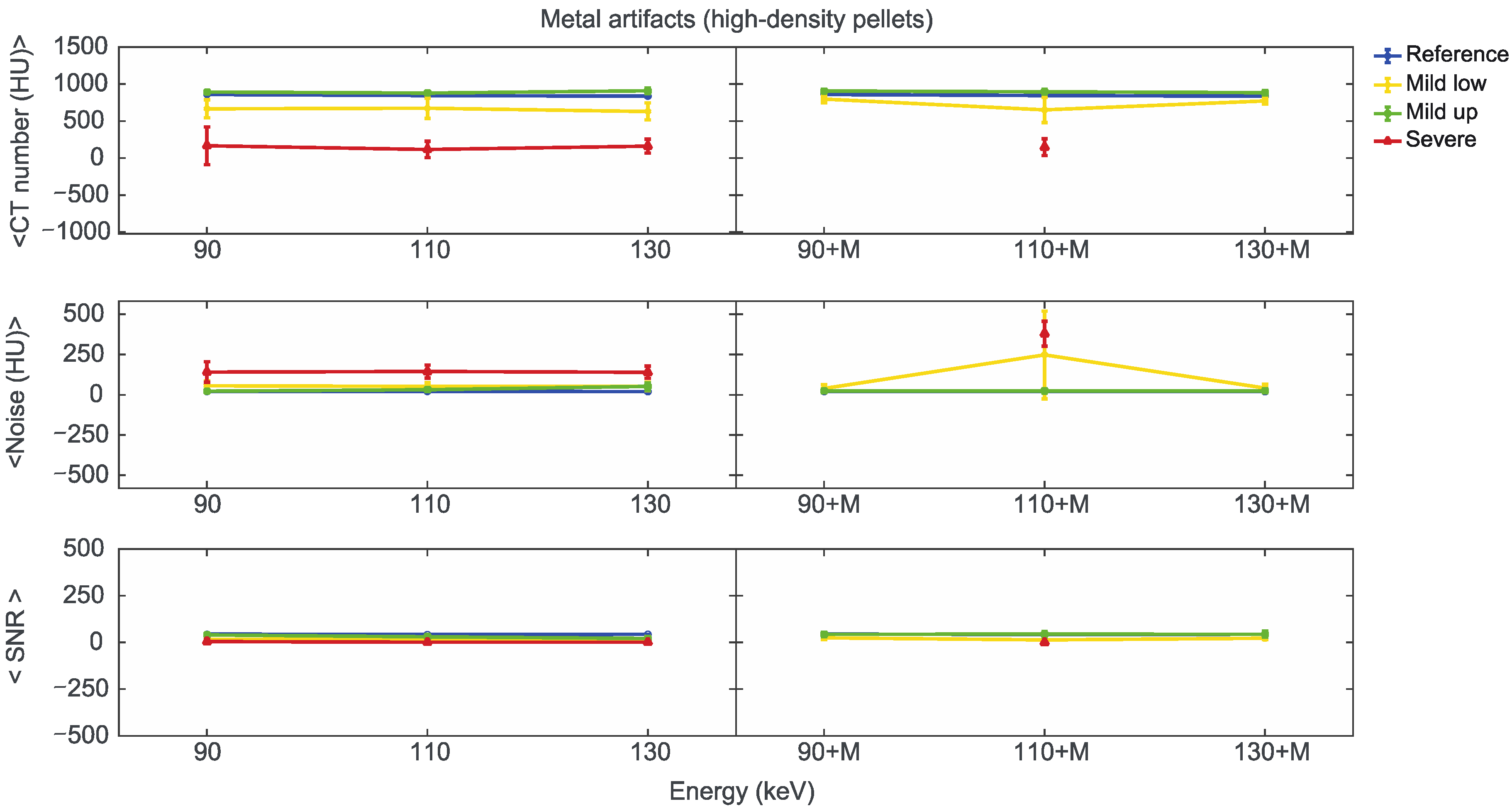
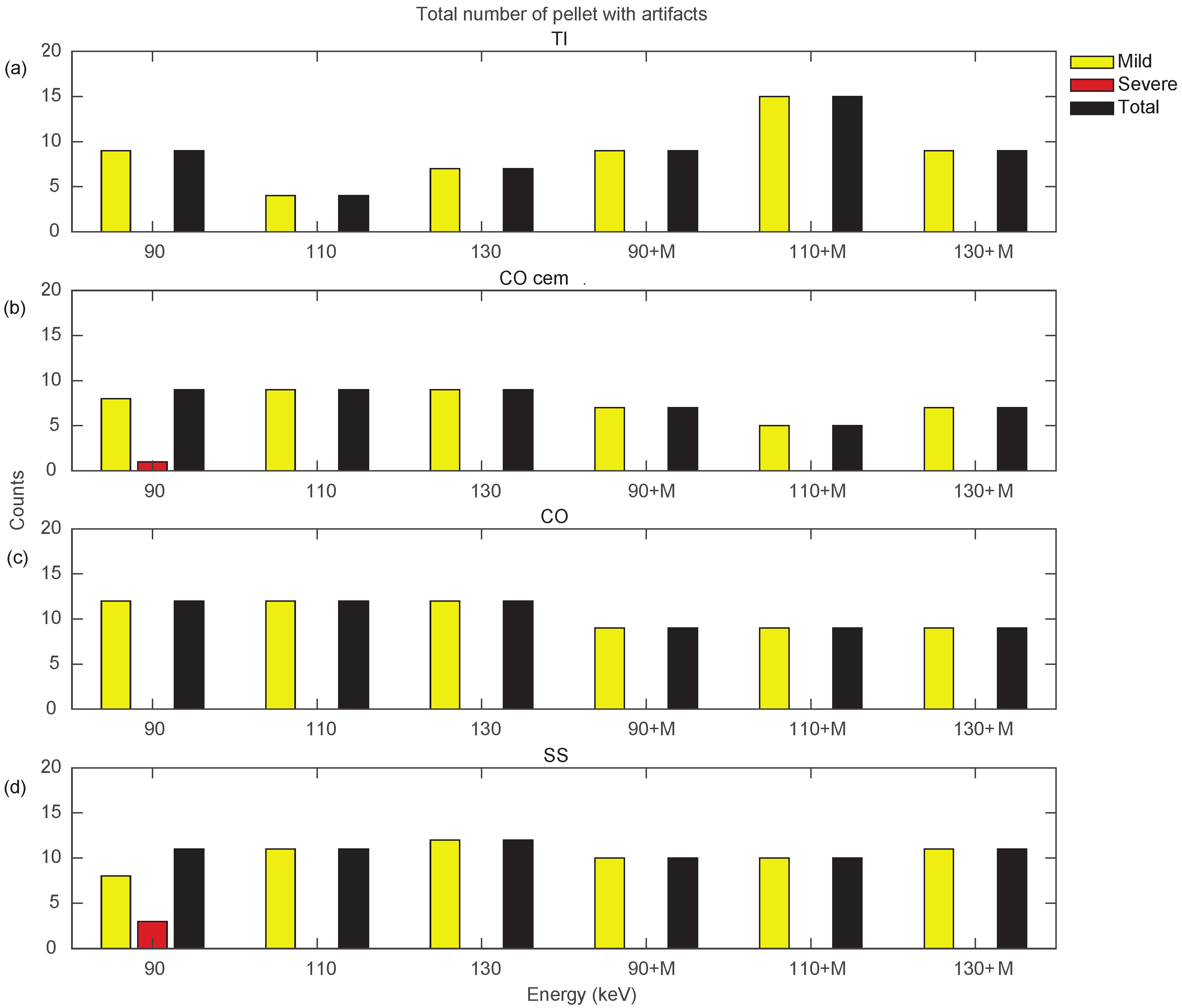
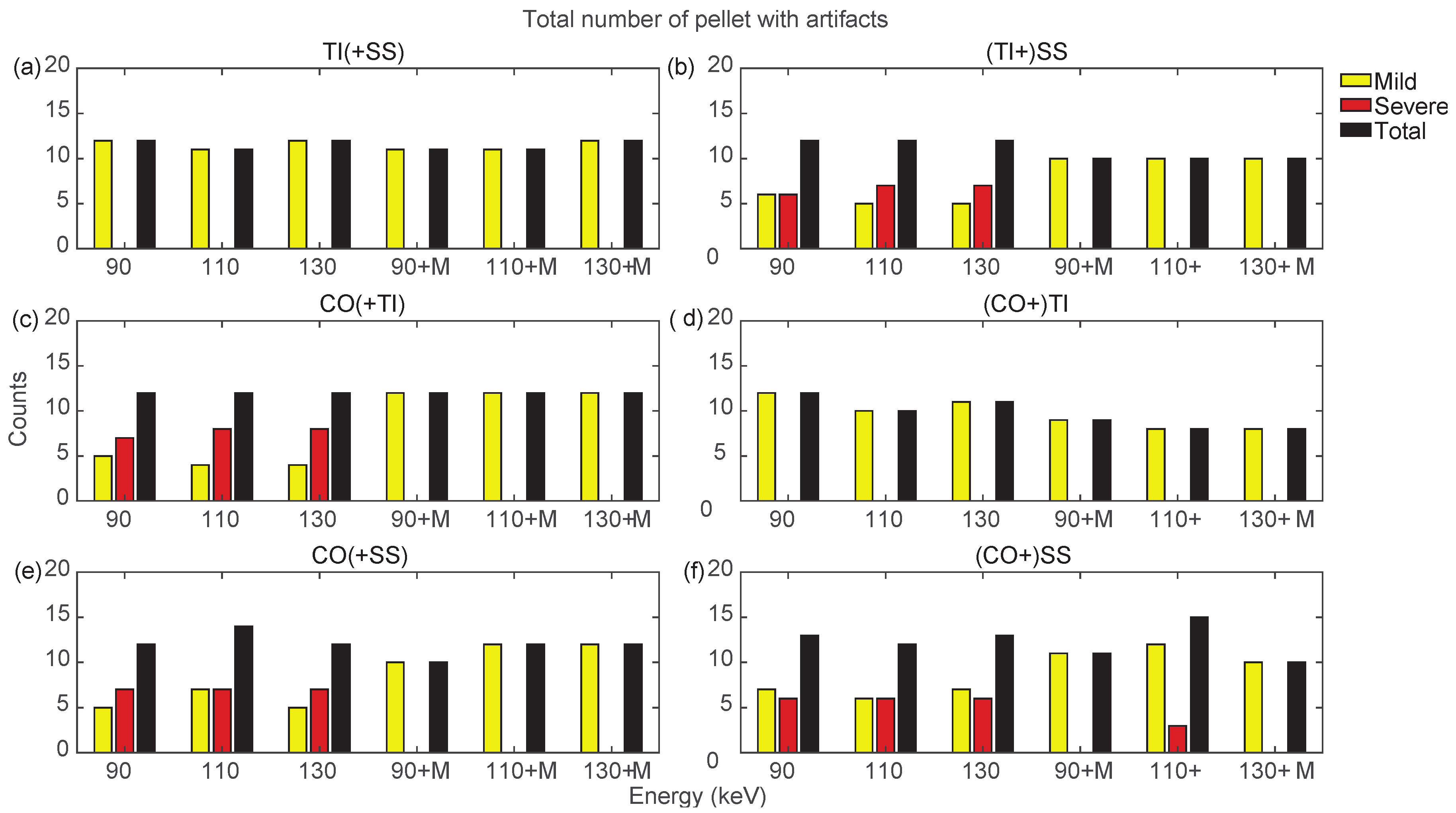
| Configuration | Right Side | Left Side |
|---|---|---|
| Reference | NO PROSTHESIS | NO PROSTHESIS |
| TI | Stem: Ti6Al4V Cup: Ti6Al4V Insert: zirconia toughened alumina Head: zirconia toughened alumina | NO PROSTHESIS |
| CO cem. | Stem: CoCrMo cemented Cup: Ti6Al4V Insert: UHWMPE Head: CoCrMo | NO PROSTHESIS |
| CO | Stem: CoCrMo Cup: stainless steel Insert: UHWMPE Head: CoCrMo | NO PROSTHESIS |
| SS | Stem: stainless steel Cup: stainless steel Insert: UHWMPE Head: stainless steel | NO PROSTHESIS |
| TI+SS | Stem: Ti6Al4V Cup: Ti6Al4V Insert: zirconia toughened alumina Head: zirconia toughened alumina | Stem: stainless steel Cup: stainless steel Insert: UHWMPE Head: stainless steel |
| CO+SS | Stem: CoCrMo Cup: stainless steel Insert: UHWMPE Head: CoCrMo | Stem: stainless steel Cup: stainless steel Insert: UHWMPE Head: stainless steel |
| CO+TI | Stem: CoCrMo Cup: stainless steel Insert: UHWMPE Head: CoCrMo | Stem: Ti6Al4V Cup: Ti6Al4V Insert: zirconia toughened alumina Head: zirconia toughened alumina |
| Number from Pellet (HU) | Artifact Level on Pellet |
|---|---|
| (NCT − σ)i,j < CTi,j < (NCT + σ)i,j | Not affected |
| (NCT + σ)i,j < CTi,j < (NCT + σ)i,j + T | Mild up |
| (NCT − σ)i,j − T < CTi,j < (NCT − σ)i,j | Mild low |
| CTi,j < (NCT − σ)i,j − T | Severe |
| Virtual Monochromatic Imaging (VMI) | Virtual Monochromatic Imaging + Metal Artifact Reduction Spectral Algorithm (VMI + MARS) | |||||
|---|---|---|---|---|---|---|
| Prosthesis | 90 keV | 110 keV | 130 keV | 90 keV + MARS | 110 keV + MARS | 130 keV + MARS |
| TI | ✓ | |||||
| CO cem. | ✓ | |||||
| CO | ✓ | ✓ | ✓ | |||
| SS | ✓ | ✓ | ||||
| TI(+SS) | ✓ | ✓ | ✓ | |||
| (TI+)SS | ✓ | ✓ | ✓ | |||
| (CO+)TI | ✓ | ✓ | ||||
| CO(+TI) | ✓ | ✓ | ✓ | |||
| CO(+SS) | ✓ | |||||
| (CO+)SS | ✓ | |||||
Disclaimer/Publisher’s Note: The statements, opinions and data contained in all publications are solely those of the individual author(s) and contributor(s) and not of MDPI and/or the editor(s). MDPI and/or the editor(s) disclaim responsibility for any injury to people or property resulting from any ideas, methods, instructions or products referred to in the content. |
© 2022 by the authors. Licensee MDPI, Basel, Switzerland. This article is an open access article distributed under the terms and conditions of the Creative Commons Attribution (CC BY) license (https://creativecommons.org/licenses/by/4.0/).
Share and Cite
Conti, D.; Baruffaldi, F.; Erani, P.; Festa, A.; Durante, S.; Santoro, M. Dual-Energy Computed Tomography Applications to Reduce Metal Artifacts in Hip Prostheses: A Phantom Study. Diagnostics 2023, 13, 50. https://doi.org/10.3390/diagnostics13010050
Conti D, Baruffaldi F, Erani P, Festa A, Durante S, Santoro M. Dual-Energy Computed Tomography Applications to Reduce Metal Artifacts in Hip Prostheses: A Phantom Study. Diagnostics. 2023; 13(1):50. https://doi.org/10.3390/diagnostics13010050
Chicago/Turabian StyleConti, Daniele, Fabio Baruffaldi, Paolo Erani, Anna Festa, Stefano Durante, and Miriam Santoro. 2023. "Dual-Energy Computed Tomography Applications to Reduce Metal Artifacts in Hip Prostheses: A Phantom Study" Diagnostics 13, no. 1: 50. https://doi.org/10.3390/diagnostics13010050
APA StyleConti, D., Baruffaldi, F., Erani, P., Festa, A., Durante, S., & Santoro, M. (2023). Dual-Energy Computed Tomography Applications to Reduce Metal Artifacts in Hip Prostheses: A Phantom Study. Diagnostics, 13(1), 50. https://doi.org/10.3390/diagnostics13010050






